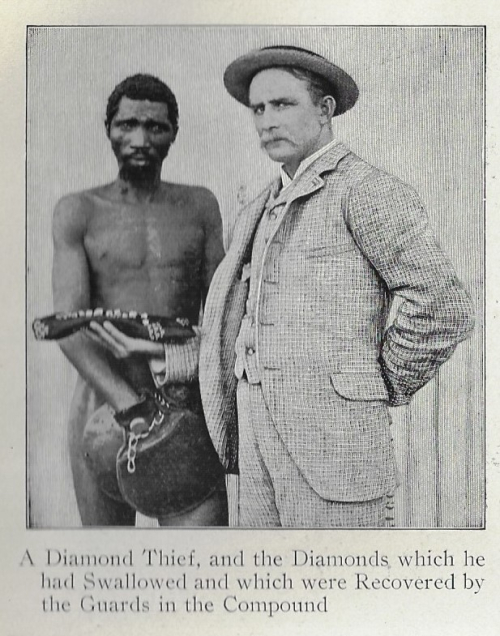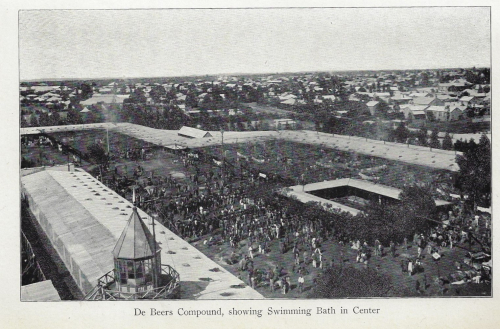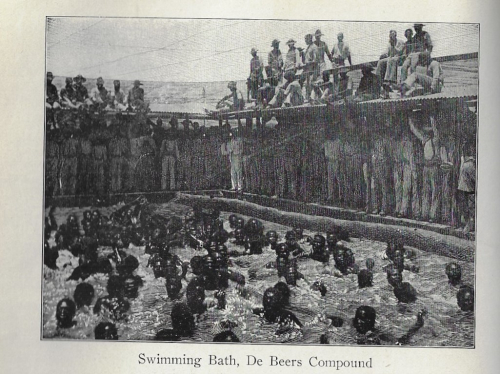JF Ptak Science Books Post 2815
 I uncovered a little cache of National Geographic magazines from 1900-1915, and picked out the 1906 volume to have a look at what I hoped for would be photo coverage of the San Francisco earthquake. There's a good and very strikingly-illustrated article to be found there, but what got my real attention was the article “The Diamond Mines of South Africa”. Actually it was one photograph that grabbed me away from the rest of the book—an image of a diamond miner who was caught stealing diamonds from the mine, extracted during his shift. It is a singularly sad photo—the man's face is pained and troubled, standing there behind a mine official, naked, and wearing gigantic baseball mitt type gloves with a heavy chain.
I uncovered a little cache of National Geographic magazines from 1900-1915, and picked out the 1906 volume to have a look at what I hoped for would be photo coverage of the San Francisco earthquake. There's a good and very strikingly-illustrated article to be found there, but what got my real attention was the article “The Diamond Mines of South Africa”. Actually it was one photograph that grabbed me away from the rest of the book—an image of a diamond miner who was caught stealing diamonds from the mine, extracted during his shift. It is a singularly sad photo—the man's face is pained and troubled, standing there behind a mine official, naked, and wearing gigantic baseball mitt type gloves with a heavy chain.
Here are a few questions that sprang to mind: Who were the workers? How did they steal” How did the company catch them? How did the company prevent such theft?
In this case the theft occurred in one of the De Beers mining facilities in South Africa. Although De Beers used convict labor, at this camp the workers were there of their own free will (I guess), joining the company to work for periods of about three months.
- “To enter the service of the company, each applicant must sign a written con tract binding himself to live in the com pound and work continuously and faith fully for a period of at least three months or longer if he so desires. At the expiration of a contract the applicant may leave if he chooses or his contract may be renewed indefinitely. Some of the natives in De Beers compound have been employed continuously for ten years or more in the service of the company,...”
 Once the contract was signed, the agreement was strictly enforced,and the lifestyle of all who worked at the mind seemed to become of one solid mass, the workers held there life inmates. It looks as though every aspect of their lives was regulated, not the least of which involved travel outside the compound or interacting with any outsiders—this to prevent the theft and exchange of diamonds.
Once the contract was signed, the agreement was strictly enforced,and the lifestyle of all who worked at the mind seemed to become of one solid mass, the workers held there life inmates. It looks as though every aspect of their lives was regulated, not the least of which involved travel outside the compound or interacting with any outsiders—this to prevent the theft and exchange of diamonds.
The article describe the general layouts of the compounds housing the diamond workers: there were 17 in the diamond fields, 12 owned by De Beer. The largest belonged to De Beer: it was 4 acres and held 3,000 workers, who were contained in the area by 10' tall corrugated iron fences; they slept 20-25 to a 25'x30' room. 3K people on 4 acres is a huge number:
- “Fully four acres are enclosed by the walls of the De Beers compound, giving ample space for the housing of its 3,000 inmates, with an open central ground for exercise and sports. The fences are of corrugated iron, rising ten feet above the ground, and there is an open space of ten feet between the fence and the buildings. At the northern end of the compound there is an entrance gate. Iron cabins fringe the inner sides of the enclosure, divided into rooms 25 feet by 30 feet, which are lighted by electricity. In each room 20 to 25 natives are lodged. The beds supplied are ordinary wooden bunks, and the bed clothing is usually composed of blankets which the natives bring with them or buy at the stores in the com pound, where there is a supply of articles to meet the simple needs of the natives...”
 Men slept on wooden bunks with a blanket and towel for bedding; at work it was reported that they wore ragged clothing if they wore anything at all.
Men slept on wooden bunks with a blanket and towel for bedding; at work it was reported that they wore ragged clothing if they wore anything at all.
De Beers sought to prevent loss by putting up a fine wire mesh netting over all open areas in the compound so that diamonds could not be thrown up and over the compound walls. When contracts expired workers who decided to leave were sent to another part of the camp to stay for a week before exiting. All of their belongings (such as they were) were either completely searched or seized. De Beers processed human waste from latrines to search for any diamonds that might have been swallowed for smuggling and which would have passed through the digestive system of a worker. All were compelled to empty their bowels before leaving the compound. Again, there was no contact with anyone from the outside. There was seemingly no hope for anyone trying to smuggle out diamonds—even those who had opened their skin to implant diamonds were found out, as there was a thorough medical examination to search out this very thing. There is no mention of what the punishment was for this sort of theft. My guess is that thew worker would be sent back to the mines, but this time working longer and for no money.
Overall, this is just not a pretty picture.


Comments